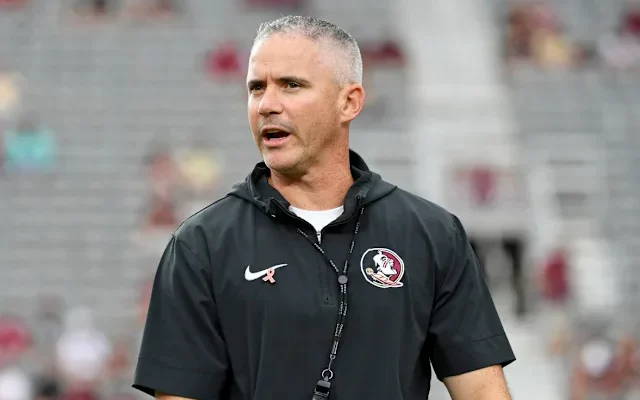In a stunning development that has sent ripples through the college football recruiting landscape, Kentucky has lost a highly touted four-star recruit from the 2026 class to Florida State, signaling a significant shift in the balance of power in Southeastern recruiting battles. For years, the University of Kentucky has been steadily building a reputation as a program on the rise, combining strong coaching leadership, improved facilities, and a growing presence in national recruiting circles. The Wildcats’ trajectory under head coach Mark Stoops has been one of methodical growth, emphasizing player development, academic support, and competitive scheduling. Yet, despite these efforts, the unexpected departure of this four-star prospect to Florida State highlights the challenges Kentucky faces in competing against established powerhouses with long-standing recruiting pedigrees.
This recruit, whose skills and versatility had been generating buzz among scouts and analysts, had long been considered a potential cornerstone for Kentucky’s 2026 recruiting class. Reports indicated that the athlete was highly rated for his ability to impact the game in multiple ways, whether on offense or defense, demonstrating a rare combination of athleticism, football IQ, and leadership qualities. Kentucky’s recruiting pitch had centered around the opportunity for immediate playing time, personal development under experienced coaches, and the chance to contribute to a program that has steadily made its mark in the Southeastern Conference. Despite these promises, Florida State’s offer ultimately proved irresistible, showcasing the enduring allure of the Seminoles’ national profile, storied history, and reputation for producing NFL-ready talent.
Florida State’s recruiting success in securing this commitment speaks volumes about their strategic approach to talent acquisition. The Seminoles have consistently emphasized not only athletic excellence but also the comprehensive development of their athletes, combining state-of-the-art training facilities with a proven coaching staff capable of turning high school stars into professional prospects. For recruits, the combination of exposure, competitive opportunity, and developmental support can often outweigh proximity or program loyalty, especially in high-profile recruiting battles. This latest commitment reinforces Florida State’s image as a program capable of attracting elite talent, even in competitive recruiting regions traditionally dominated by SEC programs such as Kentucky.
For Kentucky, the loss is multifaceted. Beyond the immediate impact on their 2026 recruiting class, this development raises questions about the program’s ability to retain top-tier talent in an increasingly competitive landscape. While Kentucky has made strides in cultivating a strong football culture, including investments in facilities, academic support, and coaching stability, they face the perennial challenge of competing with programs that carry both historical prestige and national recognition. The departure of this recruit may serve as a wake-up call, emphasizing the need for continued innovation in recruiting strategies, stronger relationship-building with prospects, and perhaps an even greater emphasis on the unique advantages Kentucky can offer, such as immediate impact opportunities, individualized coaching, and a supportive community environment.
Analysts examining this situation note that the dynamics of college football recruiting have evolved significantly over the past decade. While traditional powerhouses have long relied on brand recognition and historical success to attract talent, programs like Kentucky have sought to leverage alternative advantages, including player development, a family-like team culture, and a pathway to early playing time. However, the case of this four-star recruit suggests that these strategies, while effective in many scenarios, may still fall short when competing against programs with both national exposure and a track record of producing professional-level athletes. In an era where social media, televised games, and highlight reels amplify the visibility of certain programs, recruits are increasingly drawn to environments where they feel they can maximize both immediate and long-term career potential.
From the perspective of the recruit, the decision to commit to Florida State likely involved a complex calculus of factors beyond the traditional metrics of proximity or familiarity. Considerations such as the coaching philosophy, offensive or defensive schemes, team culture, and even the trajectory of current roster players at the position may have played crucial roles. Florida State’s ability to present a compelling vision of both athletic and personal growth, along with clear pathways to national exposure and professional development, likely tipped the scales. Moreover, the Seminoles’ reputation for competing in high-profile games and participating in postseason opportunities may have provided an additional layer of incentive, creating an environment where the recruit can showcase skills on the biggest stages while receiving mentorship from seasoned coaches.
Kentucky’s response to this loss will be critical in shaping both the immediate 2026 recruiting class and the broader perception of the program in upcoming recruiting cycles. Historically, programs that experience such setbacks have two potential pathways: they can either recalibrate and double down on recruiting efforts, leveraging the loss as a rallying point to secure other high-profile commitments, or they risk a cascading effect where subsequent prospects question the program’s ability to compete for elite talent. For Kentucky, the former approach appears most likely, given the administration’s commitment to program growth and head coach Mark Stoops’ track record of resilient recruiting. Efforts may include intensified scouting, stronger outreach to overlooked prospects, and an emphasis on showcasing Kentucky’s unique competitive and developmental advantages to offset the appeal of traditional powerhouses like Florida State.
The implications of this recruiting outcome extend beyond a single athlete. Recruiting success is the lifeblood of college football programs, directly impacting on-field performance, fan engagement, and long-term program stability. For Kentucky, securing and retaining high-caliber talent is essential to sustaining competitiveness within the SEC, a conference renowned for its depth, intensity, and national prominence. Every lost recruit represents both a tangible gap in roster depth and a symbolic challenge to the program’s narrative of upward momentum. Conversely, for Florida State, the acquisition of this four-star talent reinforces a positive recruiting narrative, signaling to other prospects that the Seminoles remain a destination capable of attracting elite players even amid the complex recruiting landscape of the modern era.
Furthermore, this development underscores the increasingly national scope of recruiting battles. While Kentucky and Florida State may traditionally operate in distinct geographic recruiting spheres, the mobility and reach of top-tier talent today mean that boundaries are far less rigid. Digital scouting platforms, highlight reels, social media interactions, and virtual communication have enabled programs to engage with prospects across state lines more effectively than ever before. Consequently, programs must be proactive and strategic in conveying their value proposition to recruits, ensuring that their pitch resonates both on a practical level—such as playing opportunities and facilities—and on a visionary level, illustrating how the program can serve as a springboard to greater athletic and professional achievement.
In analyzing the broader context of SEC and ACC recruiting trends, it becomes apparent that the competition for four-star and five-star recruits has intensified across conferences. Programs must contend not only with traditional regional rivals but also with teams outside their immediate geographic footprint, each presenting unique advantages and incentives. Florida State’s successful recruitment of this Kentucky target exemplifies how established programs can leverage history, national recognition, and a proven development system to sway top-tier talent. For Kentucky, the loss may prompt an internal evaluation of recruiting practices, emphasizing the need for early engagement, relationship-building, and strategic positioning to remain competitive on a national scale.
Finally, the human element of this recruiting story cannot be overlooked. For the athlete involved, the decision represents a major life choice, encompassing considerations of personal growth, family support, academic opportunities, and career aspirations. While fans and analysts may focus on the programmatic implications, the recruit’s perspective highlights the multidimensional nature of college athletics decisions. Florida State’s ability to connect with the athlete on both a personal and professional level likely played a decisive role, reflecting the importance of mentorship, trust, and alignment of values in successful recruiting endeavors.
In conclusion, Kentucky’s loss of a coveted four-star 2026 recruit to Florida State marks a pivotal moment in the ongoing narrative of college football recruiting. It highlights the challenges emerging programs face in competing with traditional powerhouses, underscores the evolving strategies required in modern talent acquisition, and emphasizes the multifaceted considerations that drive athlete decisions. While the immediate impact on Kentucky’s roster is tangible, the broader lesson lies in the necessity of strategic adaptation, creative recruiting approaches, and the cultivation of both athletic and personal development pathways that resonate with elite prospects. For Florida State, the victory reinforces a narrative of sustained excellence, national reach, and effective talent development, solidifying their position as a dominant force in collegiate recruiting and setting the stage for continued success in the 2026 class and beyond. Kentucky, however, faces a moment of reflection and opportunity, with the chance to refine strategies, reengage with remaining prospects, and demonstrate that the program’s trajectory is upward despite the setback, ensuring that future recruiting classes continue to position the Wildcats as competitive contenders on the national stage.



